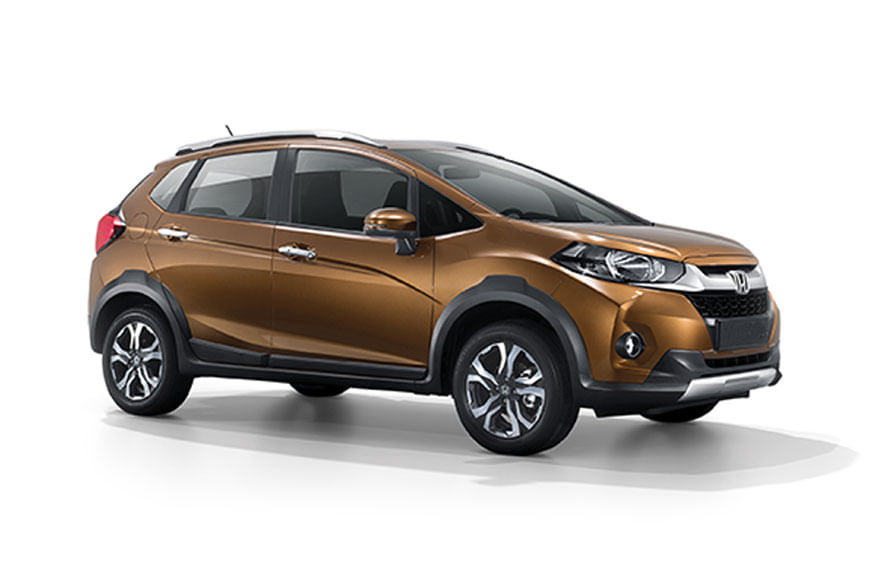2017 Honda WR-V review, test drive
Honda’s Jazz-based cross-hatch comes with a tough-looking front-end, revised suspension and loads of kit. We drive it.
Updated on Mar 17, 2017 02:16:12 PM
69,842 Views
Follow us on



What is it?
With cross-hatches, carmakers have kept the formula simple – take their existing hatches, inject some testosterone with thick slide cladding, roof rails, larger wheels and voila! We have an all-new model. The i20 Active, the Etios Cross and the Cross Polo, all seem to toe this line of thought (except the Fiat Urban Cross – but it hardly sells!).
With the new WR-V, Honda has made an honest effort to create a Jazz-based crossover that stands out from its donor car. Not just in terms of its SUV-inspired looks, which gives it a different persona, especially when viewed from the front and rear. But also in the way it has gone about tweaking the suspension, raising ground clearance and adding a few more features to differentiate it from the Jazz.
| Honda WR-V Price, Mileage, Specifications, Features and Variants | |
|---|---|
| Brand | Honda |
| Model Name | WR-V |
| Honda WR-V Price | ₹ 9.63 - 13.13 lakh |
| Honda WR-V Range/Mileage | Petrol : 17.5kpl | Diesel : 25.5kpl |
| Honda WR-V Specifications | Hatchback | 5 doors | 5 seats View All Specs |
| Honda WR-V Features | Halogen headlight | 7-inch Touchscreen display | 2 airbags View All Features |
| Honda WR-V Variants | 1.2 i-VTEC S | 1.5 i-DTEC S | 1.2 i-VTEC VX View All Variants |
What is in common is most of its siblings’ good bits like a spacious cabin and a huge boot. It also shares the same set of engines, a 90hp 1.2-litre petrol and a 100 hp 1.5-litre diesel paired with 5- and 6-speed manual transmissions, respectively. An automatic does not seem to be on the horizon anytime soon unlike the Jazz which comes equipped with a CVT gearbox option.
The WR-V is expected to be launched by March 16, with prices expected to be between Rs 7 lakh and Rs 10 lakh.
What’s it like on the outside?
Look at the WR-V from the front and you’ll be forgiven to think that it's an all-together new car. Honda has done a fine job of endowing it with a beefier ‘SUV’ look, a raised bonnet line, a thick chrome grille, a contrasting scuff plate and a sculpted bumper. The headlights come with daytime-running LEDs and look attractive. The rear end too is unique to the WR-V with its L-shaped tail lamps, revised bumper and a fairly revised tailgate design that now sees the number-plate slot positioned lower than in the Jazz.
The car's sides are where you can draw the most visual similarities with the Jazz, with familiar bodyline and glasshouse. There are some unique bits too, with the WR-V getting thick plastic cladding, chrome door handles, roof rails and larger 16-inch alloys wheels that ride on wider 195 mm rubber.
The WR-V is 44mm longer, 40mm wider and 57mm taller than the Jazz; surprisingly its 2,555mm wheelbase is 25mm longer than the Jazz, (Honda says, it is due to revised suspension mounting points). The WR-V will be offered in six colours, including a new ‘Premium Amber’ shade.
What’s it like on the inside?
The insides are a lot more similar to the Jazz. However, the WR-V’s raised stance has made ingress and egress easier; interiors follow a black theme but with a lot more chrome highlights to add to a premium look, and the upholstery is in either blue or black depending on the variant. A centre armrest is a nice addition.
The rest of the cabin remains unchanged and carries forward the Jazz’s strong points. Visibility outside is good with a large glasshouse area, but the thick A-pillar can be obstructive at times. To many, the talking point will be the WR-V’s sunroof which is a first-in-segment. Also, there's plenty of storage with several cubby holes and bottle holders around the cabin. The armrest console now houses a second USB and a power socket, in addition to those on the dashboard. The WR-V offers tremendous amounts of space both in the front and back. The front seats are large and supportive, and comfortable as well. The rear seat too is comfortable with vast legroom and shoulder room but the seat base is a bit too short leaving the occupant’s legs unsupported. Sadly, though, the Jazz’s excellent ‘Magic seats’, which can be folded in various options, do not make it to the WR-V. When asked why, Honda attributed it to a lower-priority feature for a price-conscious Indian customer. The seats do flip fully in case you need more boot space. The boot itself is a huge 363 litres, well-shaped and easy to load luggage into.
Honda’s new Digipad infotainment system that made a debut in the facelifted City finds a place in the top-spec WR-V as well. This 7-inch touchscreen system is easy on the eye, intuitive to operate and comes loaded with features like Wi-Fi (use your smartphone as a hotspot and it will connect to it), MirrorLink smartphone integration, navigation with real-time traffic data and 1.5GB of onboard storage. Connectivity gets a boost with two USB slots, two microSD card slots and an HDMI port. Like the new City, it also gets a reversing camera with multi-views; this definitely helps while reversing, especially in tight spaces.
The WR-V gets an engine start/stop button and cruise control, but surprisingly only on the diesel model.
What’s it like to drive?
The 1.2-litre petrol is the same refined unit as in the Jazz and churns out a healthy 90hp.
Its low-end performance is decent at slow speeds. The power delivery, however, gets a bit flat at mid revs warranting the need to shift to a lower gear if you want to move ahead quickly. This is crucial for overtaking in slow-moving traffic. But gear changes will be less of a hassle because of the light and easy-to-use clutch. However, the top-end in true Honda fashion is great with the engine urging you to rev it faster, while it pulls quite easily. The petrol WR-V’s 5-speed manual is smooth. But the new gearshift knob is small and is difficult to grip, which one will take time to get used to.
The diesel is the familiar 1.5-litre i-DTEC unit that churns out 100 hp. This engine, like always, offers good low-end drivability with a smooth power delivery and is also very efficient with Honda claiming a figure of 25.5kmpl. Refinement levels continue to be a sore point with loud engine noise and a lot of clatter. This one comes equipped with a 6-speed manual but the clutch is slightly heavy to operate.
The WR-V rides on a slightly higher suspension compared to the Jazz, but this has not had any adverse effect on its handling which inspires confidence at high speeds. Body roll too is fairly contained. With its larger 16-inch wheels that ride on 195/60 profile tyres, the WR-V absorbs bumps pretty decently – certainly better than the Jazz and will handle any pothole-riddled urban street rather well.
The electric power steering is from the Jazz and has been re-calibrated for the WR-V. It offers more assistance at lower speeds and can be twirled with ease. The steering is precise and offers good feedback, which makes it enjoyable at higher speeds.
Should I buy one?
Honda has entered the party a bit late with its WR-V. But this one makes a strong case for itself. Its beauty isn’t just skin-deep with a few frills thrown in. Honda has made quite the effort, butched up the looks (especially in the front), done a few but crucial engineering changes and packed in quite a bit of kit too; the sunroof will be a huge draw. Practicality, space and user–friendliness – hallmarks of the Jazz – show their presence in the WR-V.
This segment of the cross-hatch is a market niche where most players are mere posers. The only other capable cross-hatch that displays these kinds of traits – the Fiat Avventura/Urban Cross – does not sell as much.
The WR-V is expectedly priced over the Jazz and the premium ranges from Rs 81,000 on the diesel VX going all the way up to Rs 1,23,000 for the petrol S. It seems a bit steep, but with its convincing SUV looks, improved ride and handling, along with a whole lot of kit on offer, the WR-V could give not only its cross-hatch competition, but also other compact crossovers a run for their money.
Copyright (c) Autocar India. All rights reserved.





Comments
Member Login
Personal Details
No comments yet. Be the first to comment.